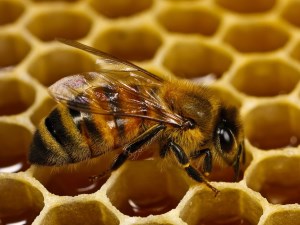A new study into honeybee eyesight has the potential to improve the vision of robots according to Australian scientists.
The research conducted at the University of Adelaide in South Australia was a collaboration with Lund University in Sweden. It demonstrated that bees had vision up to 30 per cent better than previous studies suggested.
The findings come from "eye tests" given to western honeybees (also known as European honey bees, Apis mellifera) to discover the smallest well-defined item a bee could see and how far away a bee could detect an object.
Dr Steven Wiederman from the University of Adelaide’s Medical School said the results not only helped scientists understand insects more broadly but they held the potential to develop better robots.
“We've shown that the honey bee has higher visual acuity than previously reported. They can resolve finer details than we originally thought, which has important implications in interpreting their responses to a range of cognitive experiments,” he said.
“Importantly, these findings could also be useful in our work on designing bio-inspired robotics, robot vision and for basic research on bee biology.”
Dr Wiederman builds autonomous robots inspired from insects at the University of Adelaide.
He studies how insect brains see and react to their environment, then translates this onto a hardware platform.
Avoiding collisions
He said the improved artificial vision systems would mimic how insects performed complex tasks such as detecting objects in cluttered environments and avoiding collisions.
“Importantly, we see how the sensors can discriminate objects at the limits of their ability,” Dr Wiederman said.
“We are repeating these experiments in a range of flying insects to compare the sensors with their behavioural capabilities.”
Bee vision has been studied since the pioneering research of Dr Karl von Frisch in 1914, which reported bees' ability to see colours through a clever set of training experiments.
In this study, researchers took electrophysiological recordings of the neural responses occurring in single photoreceptors in a bee's eyes.
These photoreceptors are detectors of light in the retina, and each time an object passes into the field of vision, it registers a neural response.
Sharing expertise
The results found that bees could clearly see objects as small as 1.9°, approximately the width of a human thumb when an arm is fully extended. This is 30 per cent better than previously recorded.
Bees could also notice objects at about 0.6°, a third the size of a thumb at arm’s length and five times smaller than what was detected in past experiments.
Dr Wiederman said the Lund University collaboration allowed researchers to share expertise as well as have access to both the northern and southern hemisphere recording seasons, when the insects were available for study.
Research lead from Lund University Elisa Rigosi said the honeybee was a fascinating model among scientists, especially with neuroscientists.
Escaping from predators
"These new results suggest that bees have the chance to see a potential predator, and thus escape, far earlier than what we thought previously, or perceive landmarks in the environment better than we expected, which is useful for navigation and thus for survival," she said.
The results of their work are published today in the Nature journal Scientific Reports.
The research has been supported with funding from the Australian Research Council (ARC), the Swedish Research Council, and the Swedish Foundation for International Cooperation in Research and Higher Education.
South Australia’s capital Adelaide has three long-standing public universities, Flinders University, University of South Australia and the University of Adelaide, each of which are consistently rated highly in the international higher education rankings.
Caleb Radford is a senior writer with The Lead, South Australia


